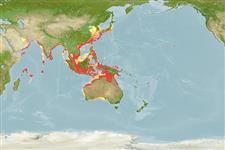Common names from other countries
>
Eupercaria/misc (Various families in series Eupercaria) >
Sciaenidae (Drums or croakers)
Etymology: Protonibea: Greek, protos = the first + see under Nibea.
More on author: Lacepède.
Issue
Type species of genus.
Environment: milieu / climate zone / depth range / distribution range
Ecologia
marinhas; estuarina demersal; intervalo de profundidade 5 - 100 m (Ref. 43239). Tropical; 40°N - 28°S, 47°E - 154°E
Indo-West Pacific: west coast of the Persian Gulf and along the coasts of India and Sri Lanka, north to Japan and south through the Philippines and Borneo to New Guinea and northern Australia.
Comprimento de primeira maturação / Tamanho / Peso / Idade
Maturity: Lm ?, range 85 - ? cm
Max length : 165.0 cm TL (female); common length : 100.0 cm SL macho/indeterminado; (Ref. 9772); peso máx. publicado: 0.00 g; idade máx. registrada: 8 anos (Ref. 72458)
Espinhos dorsais (total) : 10 - 11; Raios dorsais (total) : 22 - 25; Espinhos anais: 2; Raios anais : 7. 7-8 gill rakers on the lower limb of the first arch.
Found in coastal waters over muddy bottoms, off the sea-bed. Ascend tidal rivers and estuaries (Ref. 9772). Feed mainly on crustaceans and small fishes. Also caught with bottom trawls (Ref. 9772). Sold fresh and dried salted (swim bladder) in markets. An important food fish. Minimum depth range based on occurrence (Ref. 118911).
Ciclo de vida ou comportamento de acasalamento
Maturities | Reprodução | Spawnings | Egg(s) | Fecundities | Larvas
Lal Mohan, R.S., 1984. Sciaenidae. In W. Fischer and G. Bianchi (eds.) FAO species identification sheets for fishery purposes. Western Indian Ocean (Fishing Area 51). Vol. 4. FAO, Rome. pag. var. (Ref. 3490)
Status na Lista Vermelha da UICN (Ref. 130435)
CITES (Ref. 128078)
Not Evaluated
Ameaça para os humanos
Harmless
Uso pelos humanos
Pescarias: pouco comercial; Aquacultura: espécies comerciais
Ferramentas
Relatórios especiais
Baixar XML
Fontes da internet
Estimates based on models
Preferred temperature (Ref.
115969): 24.6 - 29.1, mean 28.2 (based on 1838 cells).
Índice de diversidade filogenética (Ref.
82804): PD
50 = 1.0000 [Uniqueness, from 0.5 = low to 2.0 = high].
Bayesian length-weight: a=0.00813 (0.00539 - 0.01227), b=3.07 (2.95 - 3.19), in cm Total Length, based on LWR estimates for this species & (Sub)family-body (Ref.
93245).
Nível Trófico (Ref.
69278): 3.5 ±0.6 se; based on diet studies.
Resiliência (Ref.
120179): médio(a), tempo mínimo de duplicação da população 1,4 - 4,4 anos (K=0.29-0.52; tmax=8).
Fishing Vulnerability (Ref.
59153): Moderate vulnerability (45 of 100).
